Indoor Digital Signage technology, applications, and implementation
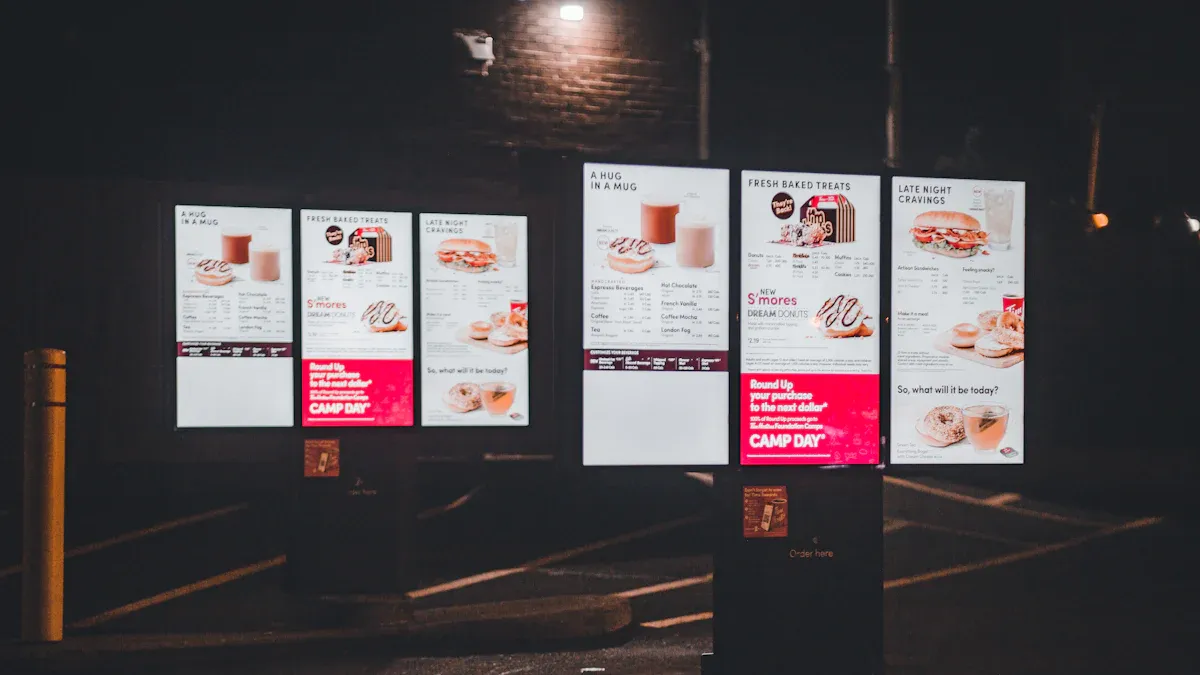
Indoor digital signage means electronic screens that show information, ads, or interactive content inside buildings. You can find these screens in stores, offices, and airports. Businesses use digital signage more now than before. The global market was $19.7 billion in 2023. It may grow to $37.4 billion by 2032.
Metric/Category | Statistic/Value | Year/Period |
|---|---|---|
Global Market Size | USD 19.7 billion | 2023 |
Projected Market Size | USD 37.4 billion | 2032 (forecast) |
Compound Annual Growth Rate | 7.7% | 2023-2032 (forecast) |
Indoor Location Segment Share | 2023 |
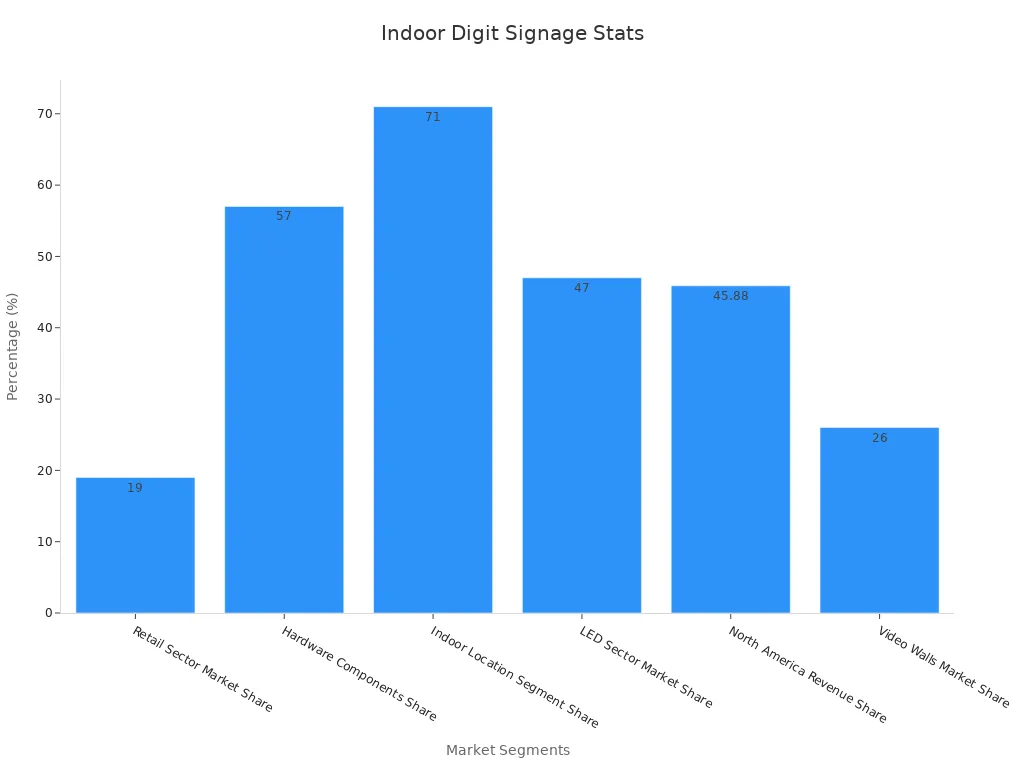
Studies say digital signage can help people pay more attention. It also helps groups share important messages fast and clearly. You can use digital signage to make communication better. It can grab attention and show new content that fits your needs.
Key Takeaways
Indoor digital signage uses bright screens inside buildings. These screens show ads, information, and interactive content. They grab people’s attention and help people talk better.
Businesses get many benefits from digital signage. It helps them get more customer interest and higher sales. It also helps people know their brand better. This makes digital signage a smart choice.
Good content is very important. Keep messages clear and simple. Update them often to keep people interested. This helps get better results.
Put screens where people gather or make choices. Good places are stores or offices. This helps get the most attention and effect.
Plan your system carefully and pick the right hardware and software. Install it safely and check it often. This keeps your digital signage working well. It also helps it grow with new trends.
Indoor Digital Signage Overview
Definition
Indoor digital signage is a group of screens inside buildings. These screens show ads, information, or fun videos. They use LED, LCD, or OLED technology. You can control all the screens from one place. This makes it easy to change what is shown. Experts say digital signage has displays, media players, and special software. Groups like POPAI and the Digital Signage Federation make rules for these systems. This technology helps you send messages to people in stores, offices, or hospitals.
Business Impact
Indoor digital signage helps many businesses do better. It can raise sales and help people talk to each other. More customers pay attention to messages on these screens. For example, 64% of users see more customer engagement. Also, 84% of retailers think digital signage is better than old signs. In restaurants, 80% of people buy things they did not plan to after seeing digital ads. Workers can also get more done, up to 25% more. The table below shows some important numbers:
Business Impact Metric | Statistic / Percentage |
|---|---|
Increased customer engagement | 64% of digital signage users report this benefit |
Improved customer service | 57% of users report improvement |
Brand awareness increase | 84% of retailers believe digital signage outperforms traditional channels |
Average purchase amount increase | 29.5% increase |
Sales increase in corporate settings | Up to 30% increase |
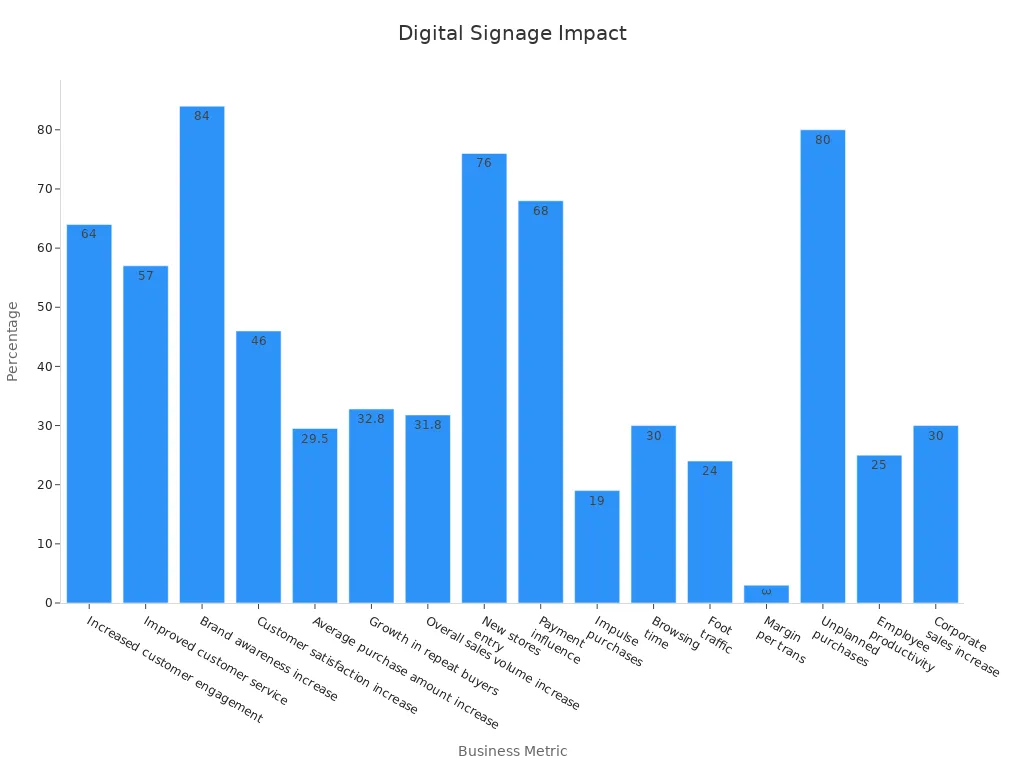
Key Features
Indoor digital signage has many helpful features. The screens are strong and can run all day. Media players let you add and plan what shows on the screens. You can control many screens at the same time. You can even do this from far away. Interactive screens help people find things or learn about products. Good mounts keep screens safe and easy to fix. Monitoring tools show how well your content works and help you fix problems fast.
Tip: Pick hardware and software that fit your space. Make sure it is easy to update your content. This will help you keep your messages new and interesting.
Digital Signage Technology
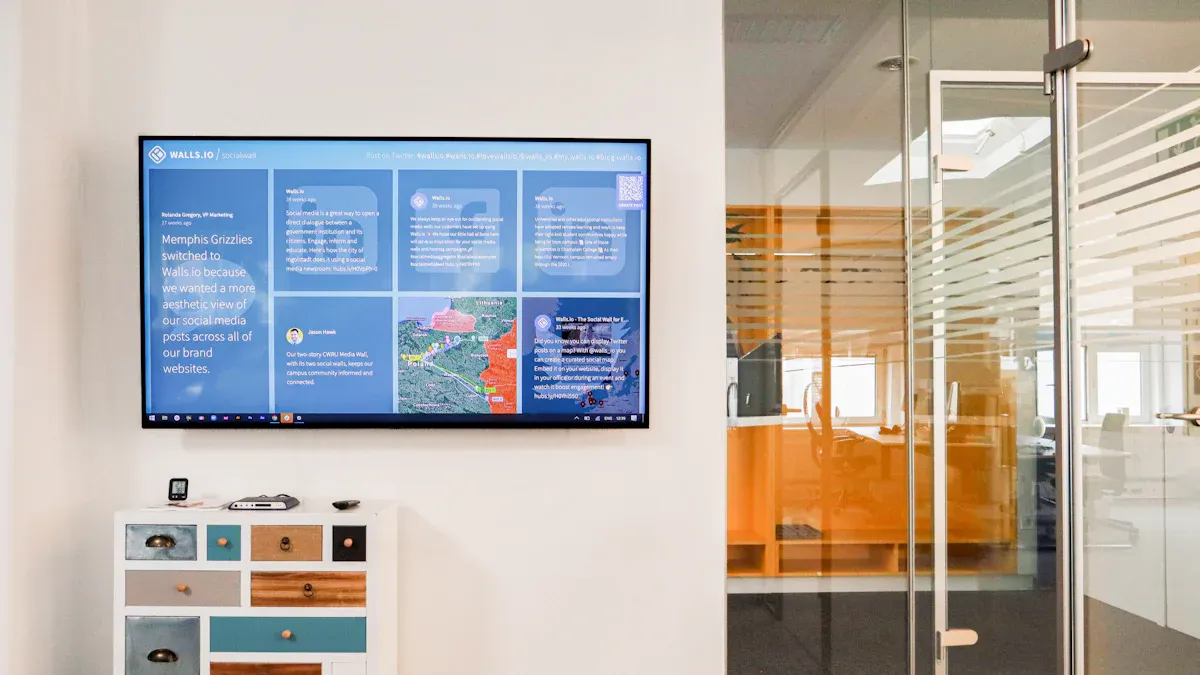
Hardware
You need good hardware for indoor digital signage to work well. Commercial-grade screens are very bright and show clear pictures. They are also strong and last a long time. These screens use LED, LCD, or OLED technology. You can pick screens from 43 inches to 85 inches. The right size helps people see the screen from near or far.
Display Model | Screen Size Options | Brightness (nits) | Resolution (pixels) | Operation Time |
|---|---|---|---|---|
Samsung Crystal UHD | 43”, 50”, 55”, 65”, 75” | 700 | 3840 x 2160 (4K) | 24/7 |
Samsung QMC Series | 43”, 50”, 55”, 65”, 75”, 85” | 500 | 3840 x 2160 (4K) | 24/7 |
Samsung QLED 8K Signage | 85” | 500 | 7680 x 4320 (8K) | 16/7 |
Media players connect to the screens and help them work well. These devices are easy to set up and update by themselves. They work with many types of screens. You get good graphics and fast movement, so your content looks smooth. Good hardware means you do not have to fix or replace things often.
Software
Digital signage software lets you control what is on your screens. Cloud-based tools help you manage content from anywhere. You can use drag-and-drop to change messages fast. Scheduling tools let you pick when each message shows up. Many platforms let you add social media, weather, or AI-powered tips.
Most digital signage software is easy to use. You do not need to be a tech expert. Simple setup and easy menus help you start quickly. You can also see how your digital signage is doing with built-in analytics. This helps you make your messages better over time.
Note: Pick software that fits your business needs. Make sure it lets you control your digital signage from far away.
Cloud Solutions
Cloud solutions make digital signage easy to use and grow. You can add more screens without buying lots of new hardware. Cloud servers keep your digital signage working well and safe.
Cloud-based digital signage lets you change content from anywhere, anytime.
You get updates and strong security to keep your data safe.
Remote monitoring helps you find and fix problems fast.
Cloud providers take care of maintenance, so you can focus on your content.
Cloud digital signage helps your system grow and stay strong. You can control many places from one dashboard. This makes your work simple and quick.
Content Is King
Content Creation
The content you show is very important for digital signage. Good content grabs people’s attention and keeps them watching. First, know who your audience is and what your business wants. Think about where you put your screens. The place you choose changes how you make your content. Use big fonts for headlines so people can read them. Make sure the body text is easy to see. Pick colors that stand out from each other.
Make layouts simple and leave lots of empty space.
Keep your text short and easy to read.
Match your design to the screen shape, like 16:9 for wide screens.
Add news or weather to keep your screens interesting.
Use touchscreens or gesture controls to let people interact.
UHD and OLED screens make your content look bright and clear. Interactive things like augmented reality let people join in. AI tools help you change content fast and show messages just for certain people. You can also show live social media posts to get more people interested.
Tip: Make your content process easy. Use digital signage software to plan and control your content.
Content Management
You need good content management to keep your screens working well. Cloud systems let you change your content from anywhere. If you update often, people will keep watching your screens. This can help you keep up to 28% more viewers. Put screens near places where people make choices, like checkouts, to get more sales. Real-time updates and planning make your content fit the moment.
Aspect | Benefit |
|---|---|
Cloud-based CMS | Easy updates from anywhere |
Frequent updates | More people watch and pay attention |
Strategic placement | More sales and more people notice |
Real-time scheduling | Content is always on time and useful |
You can use analytics to see what works best. This helps you make your content better over time. Always remember, content is the most important part of digital signage. Fun content and smart planning help you get good results.
Applications by Location
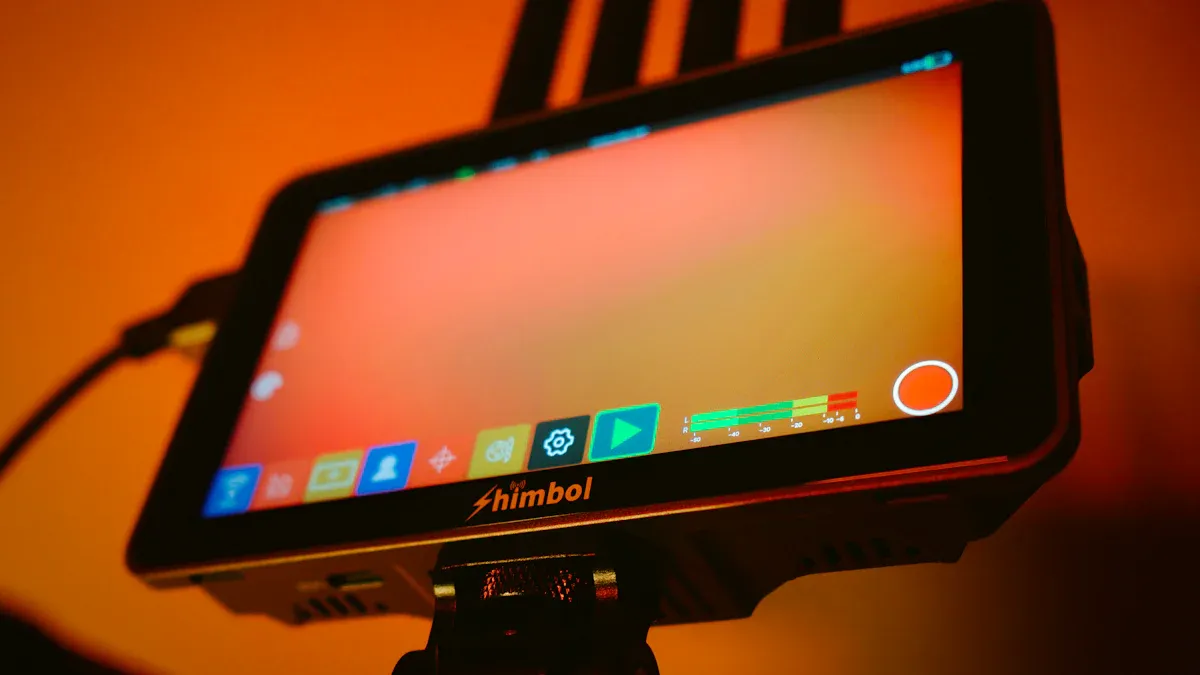
Retail
Digital signage is common in stores. Screens show new products and sales. They also display special offers to shoppers. These screens catch your eye and help stores connect with customers. McDonald's uses digital kiosks to make ordering faster and more correct. Adidas and Sephora use screens to talk to shoppers and make shopping fun. Tesla showrooms have interactive screens that teach about cars. Studies say digital signage can help stores do up to 40% better. More than 80% of shoppers buy things they did not plan after seeing digital signs. Putting screens where many people walk helps brands and boosts sales.
Corporate
Offices use digital signage to share news and updates with workers. Screens in busy places like break rooms keep everyone in the loop. This helps workers feel involved and interested. Digital signage can show videos, charts, and live news. You can use screens to celebrate team wins and show company values. This makes the brand stronger and helps everyone feel part of the team. Using digital signage saves money because you do not need as many posters. When you put screens in the right spots, more people see your messages and stay updated.
Education
Schools and colleges use digital signage to make learning more fun. You can find screens in halls, libraries, and classrooms. These screens show class times, news, and event updates. Digital signage helps with group work and gives feedback right away. Interactive lessons and games help students join in and learn more. Research says digital signage gets 400% more views than old signs. When you put screens in smart places, students pay more attention and know what is happening.
Healthcare
Hospitals and clinics use digital signage to help patients and share health tips. You see screens in waiting rooms and at entrances. These screens help people find their way and feel less worried. Digital signage can show wait times, safety tips, and health advice. Interactive kiosks let you check in or get directions. This makes visits better for patients and keeps everyone informed.
Hospitality
Hotels and resorts use digital signage to welcome guests and help them enjoy their stay. You see screens in lobbies, elevators, and restaurants. Digital signage can greet guests, show maps, and list events. Interactive kiosks help guests check in quickly. Hotels use screens to share dining deals and fun places to visit. This helps guests get involved and spend more. When screens are in the right places, service gets better and guests feel special.
Tip: Pick good spots for your digital signage. Put screens where people gather or make choices to get more attention.
Implementation Steps
Planning
Start with a good plan for your digital signage project. Decide what you want to do. Do you want to give information, entertain, or help sell things? Knowing your goals helps you pick the right screens and content. Think about who will see your screens and where they will be. Check the building for power and internet spots. Find the best places to put your screens. Work with both IT and content teams from the beginning. This teamwork makes sure your signs work well and look good.
Tip: Write down your goals and share them with your team. This helps everyone stay focused and work together.
Hardware Selection
Pick hardware that fits your goals and space. Professional displays last longer and stay bright. LCD and LED screens are used most indoors. If you want touch, choose interactive screens or kiosks. Media players can be inside the screen or separate. Built-in players save space and need fewer wires. Tablets and iPads are good for small, touch setups. Always match your hardware to your needs and budget.
Hardware Type | Best Use Case | Pros | Cons |
|---|---|---|---|
Professional Display | Busy places, all day use | Strong, bright, reliable | Costs more |
Consumer TV | Quiet places, short use | Cheaper | Not as strong, fewer tools |
Interactive Kiosk | Finding places, fun use | Touch, flexible | Harder to set up |
Built-in Media Player | Simple setup, easy updates | Less wires, simple | Harder to upgrade |
Make sure your hardware works with your content system. Cloud systems let you update from anywhere. On-premise systems give more control but need more skill. Think about how long your hardware will last and if it is easy to manage.
Installation
Good installation keeps your digital signage safe and neat. Use trained workers to set up your screens. They know the safety rules and laws. Mount screens so they do not fall and are easy to see. Put screens at the right height and angle. Connect all wires neatly. Test each screen for brightness, color, and sound before you start.
Note: Good setup stops problems later. Keep notes about your setup for future fixes.
Integration
Integration means connecting your digital signage to your other systems. First, check your network and software. Pick a platform that works with your business tools. Get your network ready for more data. Set up your content system for easy updates. Connect all hardware and test how things look on each screen.
Keep your system safe with strong passwords and encryption. Teach your team how to use and fix the system. IT and content teams should talk often. This helps fix problems fast and keeps your signs working.
Check your IT setup.
Pick a platform that fits your needs.
Get your network ready for more data.
Sync your content system for easy updates.
Test everything before you start.
Set up safety steps.
Teach your team and keep checking.
Ongoing Management
After you start, keep managing your digital signage. Change your content often to keep people interested. Use analytics to see what works best. Set goals for each campaign and track results like views and sales. Check your hardware and software often. Fix problems fast so your screens always work.
Work with both IT and content teams. Share ideas and tips. Learn about new digital signage tools and trends. This helps you make your system better and get more value.
Remember: Managing your digital signage is not just about fixing things. It is about making your signs better every day.
Best Practices & Pitfalls
Engagement Tips
You can get more people to notice your digital signage by doing a few simple things. First, make sure your content fits every screen size. Use vector graphics so pictures always look clear. Pick a content management system that changes sizes and formats for you. Use ready-made templates to keep your screens looking the same. Test your screens often to check colors and if words are easy to read. Make sure your text is big and stands out from the background.
Put screens in places where lots of people walk or wait. Add things like touchscreens or QR codes so people can interact. These features help people join in and pay more attention. Change your messages often to keep them new. Use analytics to see what people like best. Try different versions of your content and ask for feedback to learn what works.
Tip: Add interactive tools and update your screens often to make your digital signage special.
Common Mistakes
Some digital signage projects do not work because of simple mistakes. The table below lists common problems and how to fix them:
Common Mistake | Description | How to Fix |
|---|---|---|
Picking screens by price | Cheap screens may look dim and break quickly | Choose commercial-grade screens for better performance |
Bad screen placement | Screens hidden or too high get ignored | Study foot traffic and place screens at eye level |
Generic content | Broad messages do not connect with viewers | Tailor content to each location and use clear calls to action |
No tracking | You cannot measure impact without tracking tools | Add QR codes, trackable links, and connect to POS systems |
Static content | Old messages lose attention | Rotate content and review performance every week |
If you do not update your screens or test them, your results will not be good. Always plan to keep your screens working well and connect them to other systems. This helps your digital signage stay useful.
Measuring Impact
Measuring impact helps you know if your digital signage is working. Watch important numbers like how long people look at your screens and how many interact. Use special QR codes or links to count how many people respond. Compare sales and how many people visit before and after you add digital signage. Ask people questions to see if they remember your messages.
You can also use sensors or cameras to see how long people watch your screens. Social media hashtags can show if people talk about your campaigns online. Figure out if you made more money than you spent on your digital signage. Keep updating your screens and testing new ideas to get better results.
Note: Measuring impact is not just about numbers. Think about money and if you reach your goals, like getting workers involved or making your brand stronger.
Trends in Indoor Digital Signage
IoT Integration
You see more digital signage systems using IoT devices today. IoT stands for Internet of Things. This means screens can connect to sensors, cameras, and other smart tools. For example, a sensor can count how many people walk by your digital signage. The screen can then show different messages based on the time of day or the number of people nearby. You can also use IoT to check if your screens work well. If a screen has a problem, you get an alert right away. This helps you fix issues fast and keep your digital signage running.
IoT makes digital signage smarter and more useful for you.
Interactive Features
Interactive elements change how people use digital signage. You can add touchscreens, QR codes, or motion sensors. These tools let people pick what they want to see or learn more about a product. For example, in a store, you can touch a screen to find shoe sizes or colors. In a hospital, you can use a kiosk to check in for your appointment. Interactive elements make your digital signage more fun and helpful. They also help you collect feedback from users.
Touchscreens for product info
QR codes for special offers
Motion sensors for games or directions
Future Outlook
Digital signage will keep growing and changing. You will see more screens with better colors and higher resolution. AI will help you show the right message to the right person at the right time. You may also see more 3D displays and voice controls. Digital signage will become a key part of smart buildings and cities. You can expect a more dynamic experience for everyone who sees your screens.
Trend | What It Means for You |
|---|---|
AI-powered content | Smarter, targeted messages |
3D and AR displays | More eye-catching visuals |
Voice interaction | Easier ways to get info |
Stay updated on new trends to get the most from your digital signage.
Now you know how digital signage works and where to use it. Digital signage lets you share news, help sales, and give updates. You need a smart plan and good content for the best results. Always think about your goals before starting with digital signage. Look at your space and pick the right digital signage for you. Try different digital signage solutions to see what fits your business. Keep learning about digital signage so you can stay ahead.
FAQ
What is the difference between indoor and outdoor digital signage?
Indoor digital signage works inside buildings. You use it in places like stores, offices, or schools. Outdoor digital signage stands up to weather and sunlight. It uses stronger screens and cases to protect against rain, heat, and cold.
How often should you update digital signage content?
You should update your content at least once a week. Fresh content keeps people interested. Use real-time updates for news or special events. Try to plan a schedule so your screens always show something new and useful.
Can you control multiple screens from one place?
Yes, you can manage many screens from one dashboard. Digital signage software lets you change messages, check screen health, and schedule updates for all your locations. This saves you time and keeps your content consistent.
What are the main costs of indoor digital signage?
You pay for screens, media players, software, and installation. You may also pay for content creation and ongoing support. Cloud-based systems often use a monthly fee. Plan your budget to cover both starting and running costs.
Do you need special skills to use digital signage software?
Most digital signage software is easy to use. You do not need to be a tech expert. Many platforms use drag-and-drop tools. You can learn the basics quickly. Some training helps you get the best results.
See Also
Exploring Digital Signage Technology And Effective Implementation Methods
LED Digital Signage Displays: Uses, Technology, And Advantages
Strategies To Implement Digital Signage For Optimal ROI
Using Digital Signage To Enhance Information Presentation
How Digital Signage Technology Transforms Communication Effectiveness

